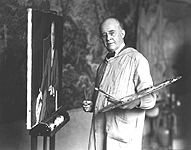
Olaf Brauner painting self -portrait.
Photograph. ca. 1922. |
As students in the 1890s came better prepared in the
technical aspects of design, the school could begin to emphasize the aesthetic and
artistic elements in architecture. The Fine Arts program at Cornell began with the
establishment of a Department of Freehand Drawing directed by Olaf Brauner, an artist and
teacher of Norwegian descent. Originally conceived as accessory to the education of
architects, Fine Arts’ offerings of drawing and painting gradually gained importance
and enrollment. Although it initially was predisposed to Beaux-Arts principles, the
program specifically intended to develop the students’ individuality. Despite
Cornell’s large collection of antique casts, the students did not trace and copy
along conventional lines, but were immediately taught to draw from live models. Brauner
encouraged some competitions in the context of public exhibitions and critiques. He also
believed in exposing his students to contemporary art, developing an ambitious exhibition
program with work by alumni and other major artists of the day. Brauner also encouraged
his students to enjoy themselves. In a letter about Willard Straight ‘01, his former
student, he described the College of Architecture as "the only college in the
university that had a real College spirit with...traditions of fun, of seriousness."
It was Straight and his class who instituted a College of Architecture Day on St.
Patrick’s Day, 1901, an event that became known as Dragon Day.
Retiring in 1939, Brauner was succeeded as chairman of the Department of Art by John
Hartell ‘25, who served until 1959, and then ran the graduate program in fine arts
until his retirement in 1968. In the 1950s the art program was redesigned as a four-year
program, basically independent of the one in architecture. In recognition of the
program’s strength, in 1967 the College of Architecture was renamed the College of
Architecture, Art, and Planning. |

